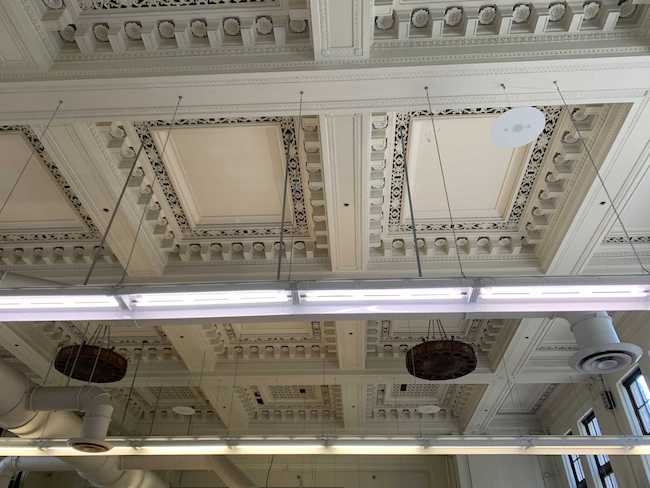Page 2 of 2
Retrofitting University Buildings for Sound Masking
Like a lot of schools, the University of Minnesota (U of MN), Twin Cities campus is replete with historic architecture. From dormitories and classrooms, student unions and libraries, to theaters and arts venues, they were not just constructed to provide students with learning facilities. The buildings themselves were meant to leave a profound impression for generations to come.
And, while their foundations and presence have survived the tests of time, their uses have often changed. Evolving a nineteenth-century building to meet twenty-first century needs poses a laundry list of challenges.
From 1920s Music Hall to 2020s Office Space
When Scott Hall was opened in 1923, it was created as the U of MN’s Music Building, complete with both classroom space and a grand auditorium. The Renaissance revival architectural style meant the auditorium featured an ornate interior capped by a lavish ceiling, together creating the atmosphere of opulence closely associated with theater buildings of the era.
But, like so many historic university buildings, its current purpose is much different than it was in 1923.

The original theater seating has long been removed and the floor has been leveled so it can function as meeting space and offices. Still beautiful and inspiring, it remains the sort of place a creative mind would love to spend 40 hours a week — except for one, very serious, flaw: sound.
Where once the planned acoustics meant even the worst seat in the house could hear a pin drop on stage, today it means audio chaos.
While the ornate, 20-foot ceilings bring light and atmosphere to the approximately 5,000-square-foot working space, the current eight-foot, ceiling-less office walls mean there’s a lot of room for sound —and, more specifically, private conversations — to carry.
In order to create a more productive, less stressful atmosphere — as well as adhering to all privacy laws — Scott Hall needed sound masking.
What is sound masking?
Sound masking is making an active acoustic effort to veil unwanted sound waves — in other words, controlling noise to a positive end.
A common example is the use of a white noise machine in an office setting which provides just enough background sound so employees can focus on their tasks without being distracted by conversations happening around them.
If you’re lucky, the machines are appropriately spaced and the white noise is evenly distributed around the room. If not, you could be stuck in a too-hot spot where the artificial sound is deafening and distracting by itself — or in a cold zone where it barely reaches you, and you can still hear others talking with enough clarity to be disruptive.
Why Sound Masking Matters
Productivity and Focus
We know for a fact that noise affects employee productivity. In study after study, the psychological effects of unwanted or disturbing sound on the workplace have been well documented. The Environmental Protection Agency (EPA) estimates that workplace noise adversely affects the lives of millions of people, resulting in complaints of stress-related illnesses, high blood pressure, and hearing loss.
When a physical space offers a little passive noise control, such as high cubicle walls, private offices or softer, sound-absorbing materials, the effects on the well-being of each person — as well as their productivity — can be profoundly impacted.
According to a study by the University of California, Irvine, productivity decreases by as much as 40 percent when impacted by noise and distractions. The study found that employees are interrupted once every 11 minutes, and it can take as much as 23 minutes to get back on task.

In the offices and meeting spaces of Scott Hall, it’s nearly impossible to avoid overhearing conversations. This creates a natural dynamic known as “sound supremacy” — when one group is distracted by another’s talking, they instinctively raise their own voices to be better heard. This, in turn, causes other groups to speak more loudly — ultimately creating a cacophony of competitive conversations.
At its best, this phenomenon is frustrating and disruptive, but at its worst, private and sensitive information is able to be overheard, thus generating awkward — and possibly even illegal — situations.
Privacy Laws
There are two privacy laws that need to be taken into consideration in terms of sound masking:
The Gramm-Leach-Bliley Act (GLBA) of 1999, which deals with private or sensitive financial information, and the
Health Insurance Portability and Accountability Act (HIPAA) of 1996, which established national standards for the safety of protected health information (PHI) — “individually identifiable health information” — transmitted in any form or media whether printed, digital or spoken.
Trying to share sensitive and personal information verbally in Scott Hall means always being within earshot of others. Both GLBA and HIPAA laws come with hefty financial penalties to both individuals and institutions that break them, making the need for sound control even more important.
How Sound Masking Works
Sound comes in what is known as a “power spectrum.” Color terms are used to explain the differences in power between types of noise. The most commonly discussed and used in sound control are “white” and “pink.”
White Noise
White noise is sound energy that contains every frequency. Similar to how white light contains all the wavelengths or colors of the visible spectrum, white noise holds a flat frequency in any bandwidth. This neatly compares to “black noise,” which holds zero frequencies in a bandwidth — in other words, “silence.”
Because of its flat, all-encompassing frequency, white noise is often perceived as “staticky.”
Pink Noise
Pink noise is sound energy containing every octave. It has power in wide bandwidths and each octave has an equal amount of noise energy. As a frequency increases, the power per hertz in pink noise decreases (whereas in white noise it stays equal).
Because of this, lower frequencies in pink noise are louder, creating the perception of even and flat sound, which is often thought of as tonally lower and more soothing. In fact, some research suggests pink noise can even have a positive effect on memory and sleep.
Both white and pink noise are used to apply a constant volume of sound in order to disguise unwanted noise. They each create an audible background of “shhhhh”— the universal “be quiet” and natural defense against sound supremacy. However, sound generators can’t simply be plugged in and turned on. Designing a sound masking system properly means controlling the artificial noise in a way that does its job without causing its own distraction.
Retrofitting Sound Control Technology in Scott Hall
To address its problematic sound issues, Scott Hall was retrofitted with planar loudspeakers, which can make use of the solid surfaces already available in the space.

These loudspeakers use an immersive audio sound control system that harnesses planar wave physics similar to that of the soundboard of a piano or the body of a stringed instrument. The speakers turn any rigid, flat surfaces in a room — such as drywall, ceiling tiles, windows, or counters (all the hallmarks of modern and popular industrial office design) — into acoustic wave amplifiers that radiate evenly, providing a constant sound pressure level (SPL) across an entire listening space.
Because these products can equally radiate all frequencies across existing, rigid surfaces, they also help any intentional sound to diminish at a shorter distance.
For example: Patients waiting in line to check in at a medical clinic can be standing closer to each other and not hear the personal information being shared at registration because the planar loudspeakers reduce the sound much more dramatically over shorter space. The experience for others, then, is of hearing muffled sounds — they know that someone is speaking but are not able to tell what they’re saying.
Because the frequencies are radiated equally across all rigid surfaces, only four planar loudspeakers were needed to cover the total affected floor space in Scott Hall. Hung from the high ceiling, these speakers look a lot like Wi-Fi boosters, are very unobtrusive, and don’t take anything away from the magnificence of the historic design.
Once the decision to use sound masking was made, the biggest challenge in retrofitting Scott Hall wasn’t even technology based — it was simply reaching the ceiling. A maintenance lift made that easy. The office staff were already working from home due to COVID-19, so the entire installation took only five hours to complete. Five hours to counteract nearly a century of acoustic power.
As COVID-19 continues to see most faculty, staff and students working and learning remotely, this has been (and continues to be) an amazing and unique opportunity for facilities to take on important construction and upgrade projects. And sound masking is a perfect candidate: a simple installation that can provide magnitudes of quiet effectiveness for decades to come.
This article originally appeared in the Fall 2020 issue of Spaces4Learning.
About the Author
Jeff Johnson is Director of Commercial AV at BLM Technologies. His responsibilities include managing vendor relationships, and developing and overseeing execution of customer solutions, including sound masking, digital signage, direct view LED walls and video distribution systems. Prior to BLM Technologies, he spent more than 15 years with Best Buy/BestBuy Direct.